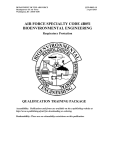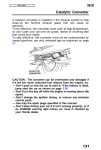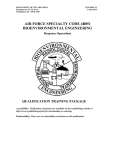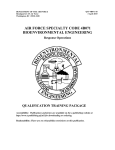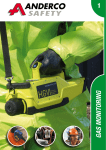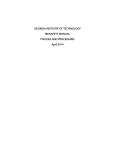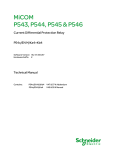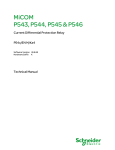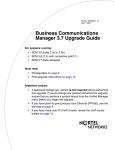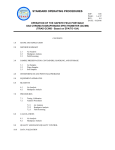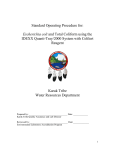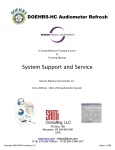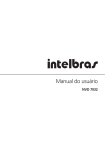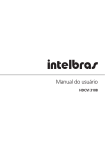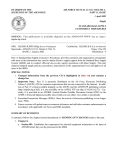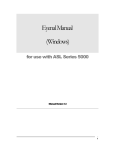Download Air Force Specialty Code 4B051 Bioenvironmental Engineering
Transcript
DEPARTMENT OF THE AIR FORCE Headquarters US Air Force Washington, DC 20330-1030 QTP 4B051-21 24 March 2015 AIR FORCE SPECIALTY CODE 4B051 BIOENVIRONMENTAL ENGINEERING Water/Liquid Sampling QUALIFICATION TRAINING PACKAGE Accessibility: Publications and forms are available on the e-publishing website at http://www.e-publishing.af.mil for downloading or ordering. Realeasability: There are no releasability restrictions on this publication. AFQTP 4B051-21 Journeyman Training Guide: Water/Liquid Sampling Table of Contents STS Line Item 4.15.3.2: Develop a water/liquid sampling strategy ....................................................................................... 1 TRAINER GUIDANCE ........................................................................................................................................................... 1 TASK STEPS ........................................................................................................................................................................... 2 TRAINEE REVIEW QUESTIONS ......................................................................................................................................... 3 PERFORMANCE CHECKLIST.............................................................................................................................................. 4 ANSWERS ............................................................................................................................................................................... 5 STS Line Item 4.15.3.3: Collect water samples from swimming pools, hot tubs, spas, natural bathing areas or other non-potable sources .................................................................................................................................................................... 6 TRAINER GUIDANCE ........................................................................................................................................................... 6 TASK STEPS ........................................................................................................................................................................... 7 TRAINEE REVIEW QUESTIONS ......................................................................................................................................... 8 PERFORMANCE CHECKLIST.............................................................................................................................................. 9 ANSWERS ............................................................................................................................................................................. 10 STS Line Item 4.15.3.5.1: Portable GC/MS (HAPSITE®).................................................................................................... 11 TRAINER GUIDANCE ......................................................................................................................................................... 11 TASK STEPS ......................................................................................................................................................................... 12 PERFORMANCE CHECKLIST............................................................................................................................................ 17 STS Line Item 4.15.3.5.2: Portable laboratory analysis kit (e.g., DREL) ........................................................................... 21 TRAINER GUIDANCE ......................................................................................................................................................... 21 TASK STEPS ......................................................................................................................................................................... 22 PERFORMANCE CHECKLIST............................................................................................................................................ 24 STS Line Item 4.15.3.5.3: FT-IR (e.g., HazMatID) ............................................................................................................... 26 TRAINER GUIDANCE ......................................................................................................................................................... 26 TASK STEPS ......................................................................................................................................................................... 27 PERFORMANCE CHECKLIST............................................................................................................................................ 29 STS Line Item 4.15.3.6: Calibrate / Operate water sampling equipment ........................................................................... 31 TRAINER GUIDANCE ......................................................................................................................................................... 31 TASK STEPS ......................................................................................................................................................................... 32 PERFORMANCE CHECKLIST............................................................................................................................................ 34 STS Line Item 4.15.3.8: Perform chlorine analysis .............................................................................................................. 36 TRAINER GUIDANCE ......................................................................................................................................................... 36 TASK STEPS ......................................................................................................................................................................... 37 TRAINEE REVIEW QUESTIONS ....................................................................................................................................... 38 PERFORMANCE CHECKLIST............................................................................................................................................ 39 ANSWERS ............................................................................................................................................................................. 41 STS Line Item 4.15.3.9: Perform pH analysis ....................................................................................................................... 42 TRAINER GUIDANCE ......................................................................................................................................................... 42 i AFQTP 4B051-21 Journeyman Training Guide: Water/Liquid Sampling TASK STEPS ......................................................................................................................................................................... 43 TRAINEE REVIEW QUESTIONS ....................................................................................................................................... 44 PERFORMANCE CHECKLIST............................................................................................................................................ 45 ANSWERS ............................................................................................................................................................................. 46 STS Line Item 4.15.3.11: Collect potable water samples...................................................................................................... 47 TRAINER GUIDANCE ......................................................................................................................................................... 47 TASK STEPS ......................................................................................................................................................................... 48 TRAINEE REVIEW QUESTIONS ....................................................................................................................................... 49 PERFORMANCE CHECKLIST............................................................................................................................................ 50 ANSWERS ............................................................................................................................................................................. 51 STS Line Item 4.15.3.12: Perform presence-absence method (Bacteriological / E. coli) .................................................. 52 TRAINER GUIDANCE ......................................................................................................................................................... 52 TASK STEPS ......................................................................................................................................................................... 53 TRAINEE REVIEW QUESTIONS ....................................................................................................................................... 54 PERFORMANCE CHECKLIST............................................................................................................................................ 55 ANSWERS ............................................................................................................................................................................. 56 ii AFQTP 4B051-21 Journeyman Training Guide: Water/Liquid Sampling STS Line Item 4.15.3.2: Develop a water/liquid sampling strategy TRAINER GUIDANCE Proficiency Code: 2b PC Definition: Can do most parts of the task. Needs help only on hardest parts. Can determine step-bystep procedures for doing the task. Prerequisites: None Training References: • AFI 48-144, Drinking Water Surveillance Program, Sept 2010 Additional Supporting References: • USAFSAM Drinking Water Surveillance Technical Guide, 2011 • Example: Sampling, Analysis, and Monitoring (SAM) Plan, ESOH Service Center • DOEHRS Water Survey Forms CDC Reference: 4B051 Training Support Material: None Specific Techniques: Conduct hands-on training and evaluation. Criterion Objective: Given a scenario, develop a liquid/water sampling strategy successfully completing all checklist items with limited trainer assistance. Notes: A sampling strategy describes the details--“what”, “when”, “where”, and “how”--of the sampling event. This training module focuses on planning the sampling event, not the tasks of identifying areas of concern that need to be sampled or sample collection. You will sample water/liquids in many diverse situations. In situations such as routine monitoring, a strategy is already defined. For example, per AFI 48-144 each installation shall have an Environmental Sampling, Analysis, and Monitoring (ESAM) Plan outlining locally developed procedures for conducting the drinking water surveillance program. These procedures should include routine monitoring, monitoring of aircraft watering points, increased monitoring for nuclear, biological and chemical (NBC) agents during contingencies or heightened Force Protection Condition, and monitoring performed before placing new connections and repaired water mains or storage tanks into use. Other non-routine situations such as characterizing a potential water source at a new deployed location will require you to develop a strategy best suited for the situation. It is not possible to address all situations in this training module; therefore, it generically addresses developing a sampling strategy for water/liquids. You will have to develop skills to apply the generic steps within the operational context of the situation at hand whether it is in-garrison, deployed, or emergency response. Scenario: The trainee has been tasked to deploy to Haiti in response to the catastrophic magnitude 7.0 earthquake which destroyed essential services and vital infrastructure to include water distribution facilities. The short-term solution was bottled water. The initial assessment team determined a primary and secondary water source. The primary source is a lake adjacent to an agricultural area. The secondary source is a river that runs parallel to the metropolitan area. 1 AFQTP 4B051-21 Journeyman Training Guide: Water/Liquid Sampling TASK STEPS 1. Identify the source/type of water/liquid to be sampled.1 2. Define the objective/purpose of the sampling.2 3. Identify contaminants of concern.3 4. Identify sample location.4 5. Identify collection method/equipment.5 6. Identify sample volume.6 7. Identify sample container.6 8. Identify preservation method.6 9. Define sampling tactics. 10. Utilize OEHMIS (DOEHRS or equivalent), as applicable. LOCAL REQUIREMENTS: NOTES: 1. Types of liquids you may sample are potable water (piped, packaged, or bottled), non-potable water (surface or ground), or unknown liquids. 2. The objective/purpose for sampling includes characterizing the hazard (initial screening to determine presence/absence of contaminants of concern or special assessments to quantify contaminants), and monitor drinking water safety as part of routine surveillance. The situation and objective for sampling can significantly influence the sampling strategy. For example, when sampling drinking water quality to assess compliance with health standards, strategies are thoroughly outlined in regulatory statutes. In contrast, initial sampling of surface water during an OESHA will take some thought and planning. Local emergency plans and checklists could also spell out courses of action for sampling in contingency situations. 3. Common contaminants of concern are heavy metals, organic and inorganic compounds, radiologicals, fecal coliform, and other biologicals. State agencies will provide requirements for the respective state. 4. Your installation ESAM Plan outlines all drinking water sampling sites used to monitor drinking water safety. A conceptual site model, if available, should also detail areas and contaminants of concern. 5. If you are collecting samples for the purpose of monitoring drinking water safety, you must use a method approved by the appropriate primary EPA regulatory agency. Standard Methods for the Examination of Drinking Water and Wastewater is another source of analytical methods. Equipment factors that contribute to the selection of a sampling device used for sampling surface waters in streams, rivers, lakes, ponds, lagoons, and surface impoundments are: width, depth, flow and accessibility of the location being sampled. Whether the sample will be collected onshore or offshore the equipment should be constructed of material that will not interfere with sample integrity via leaching and sorption of target analytes. 6. Sample volume required, the container, and required preservation method will all be specified in either the Standard Methods for the Examination of Drinking Water and Wastewater or the analyzing lab. These will vary depending on the contaminant of concern. 2 AFQTP 4B051-21 Journeyman Training Guide: Water/Liquid Sampling TRAINEE REVIEW QUESTIONS STS Line Item 4.15.3.2: Develop a water/liquid sampling strategy 1. What should be included in a SAM plan? 2. List the steps for developing a water/liquid sampling strategy. 3. What documents might you reference to select the appropriate OEEL? 3 AFQTP 4B051-21 Journeyman Training Guide: Water/Liquid Sampling PERFORMANCE CHECKLIST STS Line Item 4.15.3.2: Develop a water/liquid sampling strategy Proficiency Code: 2b PC Definition: Can do most parts of the task. Needs help only on hardest parts. Can determine step-bystep procedures for doing the task. DID THE TRAINEE… YES 1. Identify the source/type of water/liquid to be sampled? 2. Define the objective/purpose of the sampling? 3. Identify contaminants of concern? 4. Identify sample location? 5. Identify collection method/equipment? 6. Identify sample volume? 7. Identify sample container? 8. Identify preservation method? 9. Define sampling tactics? 10. Utilize OEHMIS (DOEHRS or equivalent), as applicable? Did the trainee successfully complete the task? TRAINEE NAME (PRINT) TRAINER NAME (PRINT) 4 NO AFQTP 4B051-21 Journeyman Training Guide: Water/Liquid Sampling ANSWERS 1. What should be included in a SAM plan? A: A listing of all regulatory guidance that governs your drinking water sampling, analysis, and monitoring. Identification of all drinking water sampling sites used to determine compliance with the SDWA. BE will maintain certification documents from the primacy (state or federal agency that has primary enforcement responsibility) on these sampling sites where appropriate (e.g., lead and copper sampling sites and bacteriological sites). Annual and long-range drinking water sampling schedule. Description and classification (e.g., community/non-community, transient/non-transient) of each Public Water System and approval of the description by the primacy. Typically, your responsibilities with regards to these types of systems include recreational areas and geographically separated units supported by the parent Wing or Medical Group. Locally developed procedures for conducting the drinking water surveillance program. These procedures should include a schedule for routine monitoring, monitoring of aircraft watering points, increased monitoring for chemical, biological, radiological, and nuclear. (Source: 4B051 CDC) 2. List the steps for developing a water/liquid sampling strategy. A: Step 1: State the problem Step 2: Identify the decision or goal Step 3: Identify information inputs to the decision Step 4: Define the boundaries Step 5: Develop the decision rules and analytical approach Step 6: Determine performance or acceptance criteria Step 7: Develop the detailed sampling plan (Source: 4B051 CDC) 3. What documents might you reference to select the appropriate OEEL? A: MEG- Military Exposure Guideline, Technical Guide 230, U.S. Army Public Health Command AFI- Air Force Instruction IRIS- Integrated Risk Information System, Environmental Protection Agency MCL- Maximum Contaminant Level, Environmental Protection Agency (Source: 4B051 CDC) 5 AFQTP 4B051-21 Journeyman Training Guide: Water/Liquid Sampling STS Line Item 4.15.3.3: Collect water samples from swimming pools, hot tubs, spas, natural bathing areas or other non-potable sources TRAINER GUIDANCE Proficiency Code: PC Definition: Prerequisites: Training References: 3c Can do most parts of the task. Needs help only a spot check of completed work. Can identify why and when the task must be done and why each step is needed. Complete Training Module 4.15.3.8 and Training Module 4.15.3.9 before completing this training module. These prerequisite items should be re-evaluated when completing this module. AFI 48-114, Swimming Pools, Spas and Hot Tubs, and Bathing Areas Additional Supporting References: CDC Reference: 4B051 Training Support Material: • Sterile sample containers • DPD kit Specific Techniques: Conduct hands-on training and evaluation. Criterion Objective: Given sampling supplies and equipment, collect a water sample from a swimming pool successfully completing all checklist items with NO trainer assistance. Notes: Per AFI 48-114, spas and hot tubs are not sampled routinely for bacteriological quality, but is recommended in instances of illness outbreaks (reference: Centers for Disease Control, various publications). AFI 48-114, gives information on illnesses related to spa/hot tub use. Spas and hot tubs should be sampled routinely for pH, chlorine and temperature. Use aseptic methods at all times to avoid contaminating the sample. 6 AFQTP 4B051-21 Journeyman Training Guide: Water/Liquid Sampling TASK STEPS 1. Determine appropriate sample time and location (maximum swimmer load).1 2. Measure pH and chlorine (see Training Modules 4.15.3.8 and 4.15.3.9), as applicable.2 3. Use aseptic methods at all times to avoid contaminating the sample. 4. Uncap a sterile sample container.3 5. Hold the sample container near the base at an angle of 45o. 6. Fill the sample container at a depth of approximately 0.3- 1meter (1-3 feet).4 7. Cap the sample container. 8. Properly label the sample container. 9. Properly store/transport the sample container.5 10. Utilize DOEHRS, if applicable. LOCAL REQUIREMENTS: NOTES: 1. Sampling locations should reflect water quality within the entire recreational area. You must be aware of sites upstream and adjacent to recreational areas that may influence water quality such as stormwater or wastewater discharge points. For natural bathing areas take samples over a range of environmental and climatic conditions, especially during times when maximal pollution can be expected (periods of tidal, current, and wind influences, storm water runoff, wastewater treatment by-passes). Collect samples during periods of maximum swimmer load. BE shall perform water quality sampling at natural bathing areas based on risk. Risk factors to consider include, but are not limited to, proximity to suspected pollution sources, level of bathing area use, historical water quality data, and occurrence of sewage spills or other pollution events. If local or state regulatory agencies have current data, those data may be used and BE can determine what, if any, additional parameters need to be evaluated. If BE decides not to sample at natural bathing areas, the rationale behind the decision shall be documented. 2. PH and Chlorine must be annotated for the purpose of comparison for routing sampling. Chlorine reacts with the pool water to form hypochlorite and hypochlorous acid (HOCl) which kills pathogens and is an indicator of water quality. Combined Chlorine: the amount of chlorine that has reacted with inorganic (nitrates, etc.) and organic nitrogen-containing molecules (urea, etc.) to make weak disinfectants that are unavailable for disinfection and free chlorine is the chlorine that is left over and is available to for disinfection. 3. The size of the container will vary with the number and variety of tests to be performed. Refer to AFI 48-114 and local lab standards for analytical requirements and recommendations. When sampling chlorinated sources, the sample container must contain a dechlorinating agent. 4. Fill container in one slow motion sweeping down through the water with the mouth of the container always ahead of the hand. Avoid contaminating the sample container with floating debris. Ensure the inside of the cap remains untouched while holding the inside of the cap downward. 5. Lab guidance recommends holding samples at <10oC during transport until analysis. Sampling should test for that E. coli and enterococci be used as the indicator organisms for evaluating the microbiological suitability of the water in freshwater natural bathing areas. 7 AFQTP 4B051-21 Journeyman Training Guide: Water/Liquid Sampling TRAINEE REVIEW QUESTIONS STS Line Item 4.15.3.3: Collect water samples from swimming pools, hot tubs, spas, natural bathing areas or other non-potable sources 1. Why should chlorine be used as a sanitizer? 2. What is the recommended indicator organism for evaluating the microbiological suitability of the water in freshwater natural bathing areas? 3. When can BE determine that sampling is not needed for natural bathing areas? 8 AFQTP 4B051-21 Journeyman Training Guide: Water/Liquid Sampling PERFORMANCE CHECKLIST STS Line Item 4.15.3.3: Collect water samples from swimming pools, hot tubs, spas, natural bathing areas or other non-potable sources Proficiency Code: 3c PC Definition: Can do most parts of the task. Needs help only a spot check of completed work. Can identify why and when the task must be done and why each step is needed. DID THE TRAINEE… YES 1. Determine appropriate sample time and location (maximum swimmer load)? 2. Measure pH and chlorine, as applicable? 3. Use aseptic methods at all times to avoid contaminating the sample? 4. Uncap a sterile sample container? 5. Hold a sterile container near the base at an angle of 45o? 6. Fill the container at a depth of approximately 0.3- 1 m (1-3 foot) in one slow sweep down through the water with the mouth of the container always ahead of the hand? 7. Cap the sample container? 8. Label the sample container properly? 9. Store/transport the sample properly? 10. Utilize OEHMIS (DOEHRS or equivalent), if applicable? Did the trainee successfully complete the task? TRAINEE NAME (PRINT) TRAINER NAME (PRINT) 9 NO AFQTP 4B051-21 Journeyman Training Guide: Water/Liquid Sampling ANSWERS 1. Why should chlorine be used as a sanitizer? A: Chlorine reacts with the pool water to form hypochlorite and hypochlorous acid (HOCl) which kills pathogens. (Source: 4B051 CDC) 2. What is the recommended indicator organism for evaluating the microbiological suitability of the water in freshwater natural bathing areas? A: The AFI 48–114 recommends that E. coli and enterococci be used as the indicator organisms for evaluating the microbiological suitability of the water in freshwater natural bathing areas. Enterococci shall be used as the indicator organism in marine waters. (Source: 4B051 CDC) 3. When can BE determine that sampling is not needed for natural bathing areas? A: If local or state regulatory agencies have current data, those data may be used and BE can determine what, if any, additional parameters need to be evaluated. If BE decides not to sample at natural bathing areas, the rationale behind the decision shall be documented. (Source: AFI 48-114, Swimming Pools, Spas and Hot Tubs, and Bathing Areas, Section (6.3) Water Quality) 10 AFQTP 4B051-21 Journeyman Training Guide: Water/Liquid Sampling STS Line Item 4.15.3.5.1: Portable GC/MS (HAPSITE®)* TRAINER GUIDANCE Proficiency Code: 2b PC Definition: Can do most parts of the task. Needs help only on hardest parts. Can determine step-bystep procedures for doing the task. Prerequisites: Complete Computer Based Training. Training References: • Inficon Equipment User’s Manual. • HAPSITE® Smart Plus Chemical Identification System Operating Manual (ESOH Additional Supporting References: Service Center Website) • Fundamentals of Industrial Hygiene, 5th Edition, Chapter 17. • Technical Report on BE HAPSITE® Preventive Maintenance and KD Analytical Support Guidance, July 21, 2010 • HAPSITE® PLUS SMART Guidance CDC Reference: 4B051 Training Support Material: HAPSITE® (GC/MS) VOC test sample Specific Techniques: Conduct hands-on training and evaluation. Criterion Objective: Given a HAPSITE® (GC/MS), perform pre-operational check and operate instrument successfully completing all checklist items with limited assistance on only the hardest parts. Notes: *The HAPSITE® is a gas chromatograph/mass spectrometer (GC/MS) proven to provide verifiable data for critical healthrisk decisions. The HAPSITE® systems deliver fast, dependable on-site analysis of volatile organic compounds (VOCs) in air, water, and soil for emergency response, environmental, hazardous waste, industrial hygiene, process monitoring, and medical applications. The HAPSITE® Headspace sampling system supports the HAPSITE® Smart Chemical Identification System in detecting and identifying VOCs in water or soil on-site or from another location. INFICON recommends storing the HAPSITE® Smart in extended standby mode. This keeps the NEG (pump) operating at 400°C and the ion pump ON to maintain proper vacuum conditions. Extended standby ensures the battery is charged and ready for deployment/response. While extended standby is recommended, it is not a substitute for system use and it is not a feature to extend the time period between system operations. Using the system or running a weekly Blank Run is the best method to ensure overall operational readiness. The Guidance Document (HAPSITE® Field Guide) referenced above is designed to provide user’s the capability to maximize the use of deployment technology at both garrison and deployed environments in both routine and emergency response situations. 11 AFQTP 4B051-21 Journeyman Training Guide: Water/Liquid Sampling TASK STEPS START UP FROM STANDBY MODE: (These steps are ONLY for resuming use when the HAPSITE® has been placed in STANDBY MODE.) 1. Using your thumbs, Open front panel of HAPSITE®.1 2. Insert purple-banded Nitrogen gas canister into the opening with the purple stripe2. 3. Insert yellow-banded Internal Standard gas canister into bottom canister opening marked with yellow stripe.2 4. Insert a fully charged battery into the rectangular opening to the left of the canister openings.3 5. Ensure the sample loop is installed.4 6. Navigate to main menu. 7. Allow the HAPSITE® to boot up and run auto tune check (self calibration). 5 HAPSITE® SEQUENCE OF OPERATION (SURVEY MODE): 1. Ensure HASPITE is turned on and warmed up. 2. Navigate to main screen 3. Choose “Return to Main Menu” 4. Choose “Run Method” 5. Choose JPMESG Rev 2 Methods 6. Choose JPMESG Survey 7. Ensure Tune parameters are OK, 8. Press Run and sample background in ambient air surrounding for about a minute to allow the background to drop and stabilize.6 9. Get a volatile organic compound (VOC) sample to test (e.g., toluene, acetone, gasoline). 10. Hold probe over sample for up to one minute while monitoring the TIC count. Look for a response (spike) and pull probe away. (Remember: TIC count over 60 million is indicative of oversaturation.) 11. Keep running the HAPSITE® for at least one minute away from the sample and allow background to drop again. 12. After the clean background has been obtained leave the HAPSITE® running in the clean area for a minimum of a minute prior to entering a suspected contaminated area. 13. When entering an area ensure the TIC count is being observed at all times, if the TIC count reaches 60,000,000 back away from the area. 14. Return to the clean area and let HAPSITE® run for 1 minute 15. Select Escape to end the method and return to main menu. 16. Analyse findings HAPSITE® SEQUENCE OF OPERATION (SAMPLE LOOP BLANK): 1. Ensure HASPITE is turned on and warmed up. 2. Navigate to main screen 3. Choose “Return to Main Menu” 4. Choose “Run Method” 5. Choose JPMESG Rev 2 Methods 6. Choose JPMESG GCMS 7. Ensure the Sample Loop is installed with the correct cover. Sample Loop cover will have Sample Loop written on it. 8. Select JPMESG Loop Method 9. Select gc_sl. 10. Press Run. 11. HAPSITE® will start sampling as soon as the user selects the run button. 12. Sample collection time is 60 seconds, collection of sample is indicated on the bottom of the screen as “loop fill” 13. When complete, review the blank run. It should show the following:8 • Air Peak at 1:20 +/- 10 seconds • Internal Standard #1 at 2:30 minutes +/- 10 seconds (TRIS) • Internal Standard #2 at: 8:00 minutes +/- 10 seconds (BPFB) • No additional peaks and low background All four criteria constitute a satisfactory blank run. See the figure below for an example of a good Sample Loop blank run with all three peaks identified and no additional peaks. 12 AFQTP 4B051-21 Journeyman Training Guide: Water/Liquid Sampling Sample Loop Blank Chromatogram HAPSITE® SEQUIENCE OF OPERATION (TRI-BED CONCENTRATOR BLANK): 1. Ensure HASPITE is turned on and warmed up. 2. Navigate to main screen 3. Ensure that the Tri-bed concentrator is installed with groove facing up and the appropriate cover is attached. If a problem should occur when running a concentrator, the following message may appear: No Concentrator Installed/Incorrect Concentrator: (1) Indicates the concentrator cover may not be on. (2) Indicates the concentrator is not being recognized; may be due to a chipped end at the base of tube. Chipped concentrator will show Low Column Pressure Warning.9 4. Choose “Run Method” 5. Choose JPMESG Rev 2 Methods 6. Choose JPMESG GCMS 7. Choose JPMESG Concentrator 8. Select JPMESG Concentrator Clean-out (gc_cbcl). Press Run and observe the maximum TIC during this three-minute run. If the TIC is greater than 500,000 at the end of run, repeat clean-out. 9. Note the number of clean-outs required to get TIC below 500,000, and note the actual TIC in comments.10 10. Choose “Return to Main Menu” 11. Choose “Run Method” 12. Choose JPMESG Rev 2 Methods 13. Choose JPMESG GCMS 14. Choose JPMESG Concentrator 15. Select JPMESG Tri-bed concentrator method (gc_cb1m), and press Run. (Check the Tune Report if you have not already done so.) 16. Sample collection time is 60 seconds, collection of sample is indicated on the bottom of the screen as “conc fill” 17. When complete, review the blank run. It should show the following:11 • Air Peak at 1:20 +/- 10 seconds • Internal Standard #1 at 2:30 minutes +/- 10 seconds (TRIS) • Internal Standard #2 at: 8:00 minutes +/- 10 seconds (BPFB) • No additional peaks and low background. All four criteria constitute a satisfactory blank run. See Below for an example of a good blank run. 13 AFQTP 4B051-21 Journeyman Training Guide: Water/Liquid Sampling Tri-bed Concentrator Blank Chromatogram HAPSITE® SEQUENCE OF OPERATION (HEADSPACE SAMPLING SYSTEM (HSS) SET-UP METHOD):12 1. Ensure HAPSITE® is in Extended Standby Mode. 2. Attach “Y”-Cable Power Splitter. Connect the single connector end of the cable to the Convertec, power supply. Connect one of the split ends of the cable to the left side of the HAPSITE® and the other to the back of the Headspace unit. Back of HAPSITE® Analytical Module 3. Remove probe from the HAPSITE®. Connect the HSS transfer line and ensure that the end of the HSS transfer line with the yellow label marked “This End to HAPSITE®” is connected to HAPSITE®. Connect the end of transfer line with the white label marked “This End to Headspace” to the back of the HSS. 14 AFQTP 4B051-21 Journeyman Training Guide: Water/Liquid Sampling HAPSITE® Headspace Transfer Line 4. Insert a nitrogen canister and a charged battery into the HSS and turn on the power. HAPSITE® SEQUENCE OF OPERATION (HEADSPACE TRI-BED PERFORMANCE STANDARD): 1. Select Run Method from Main Menu. 2. Select JPMESG GCMS Methods 3. JPMESG HeadSpace 4. Select Headspace. Select hs_slwqc method. 5. HAPSITE® warm-up heaters window will appear. This process takes approximately 15–20 minutes. 6. Automatic tune will initiate (see HAPSITE® LCD screen). The message Instrument is Tuned should appear. 7. Measure 20 mL of deionized or sterile water into a 40 mL vial. Inject 1 μL of the Headspace Performance Standard into the 20 mL of de-ionized water through the septum. Gently mix, and then place in the Headspace. Place a clean empty vial in the Headspace next to the vial with Performance Standard. 8. Close yellow cover and press Run to start method. Observe on HAPSITE® or laptop screen. Data file name will automatically be generated on HAPSITE® LCD screen. 9. After the run is complete, follow screen directions. Put needle in clean vial and press SEL to purge. Purging takes approximately two minutes. 10. Press SEL to view results from front panel LCD. Headspace Tri-bed Performance Test Method RECORD DATA: 1. Utilize DOEHRS or equivalent as applicable. 15 AFQTP 4B051-21 Journeyman Training Guide: Water/Liquid Sampling LOCAL REQUIREMENTS: NOTES: 1. Place hands on top of front panel, using thumbs, pull panel down and outward to open. Care should be taken not to tear the seal. 2. Insert instructions for canisters are located on the inside of the front panel and require the operator to press and hold the PUSH button located to the right of the containment area while inserting canister. With canister pushed in, release the button and this should engage the canister to stay in the containment area. If you can pull it out then it was not inserted properly. 3. The battery is loaded in the opening to the left of the canisters. The INFICON name will be in the upper left corner of the battery and the TEST button in the upper right corner when the battery has been inserted correctly. When the HAPSITE® is in extended standby a battery should be in the machine. The battery will be recharged while in extended standby. 4. Sample loop is located to the right of the canisters. When installing the Sample Loop Do Not over tighten. 5. When tune check is complete, PRESS ANY BUTTON TO CONTINUE will appear at the top of the display screen. Any button you press on the HAPSITE® will cause the display window to show the MAIN MENU. 6. TIC generally should be less than 200,000. If not, check area for inteferents such as chemicals that may be in the area. 7. Instrument will continuously run until you stop it while in Survey Mode. 8. Monitoring what a normal blank looks like is one step in verifying the operation of the HAPSITE® and determining if there is a problem. If there are additional peaks in the blank spectrum, and they cannot be removed with additional blank runs, review your blank chromatogram, note the additional analytes, and contact the ESOH Service Center. 9. It is important to blow out the ferrule chamber to ensure broken pieces of the chipped tube are not imbedded. 10. Clean-outs required. 11. If there are additional peaks in the blank spectrum, and they cannot be removed with additional blank runs, AND they are not getting in the way of other analytes, note the additional analytes, and adjust your sample spectrum accordingly. Remember that in future samples, if the chemical that showed up in the blank run is sampled, there will be an increase in peak heights. 12. The Headspace Performance Standard is a test of the HAPSITE® and Headspace connections using the Tri-bed concentrator. 16 AFQTP 4B051-21 Journeyman Training Guide: Water/Liquid Sampling PERFORMANCE CHECKLIST STS Line Item 4.15.3.5.1: Portable GC/MS (HAPSITE®) Proficiency Code: 2b PC Definition: Can do most parts of the task. Needs help only on hardest parts. Can determine step-bystep procedures for doing the task. DID THE TRAINEE… YES START UP FROM STANDBY MODE 1. Use thumbs to open front panel of HAPSITE®? 2. Insert purple-banded Nitrogen gas canister into the opening with the purple stripe? 3. Insert yellow-banded Internal Standard gas canister into bottom canister opening marked with yellow stripe? 4. Insert a fully charged battery into the rectangular opening to the left of the canister openings? 5. Ensure the sample loop is installed? 6. Press and hold the power button located on the outside of the HAPSITE®s face panel? 7. Allow the HAPSITE® to boot up and run auto tune check (self-calibration)? HAPSITE® SEQUENCE OF OPERATION (SURVEY MODE) 1. Ensure HASPITE is turned on and warmed up? 2. From Main screen, choose Press the ESC button? 3. Choose Return to Main Menu? 4. Choose Run Method? 5. Choose JPMESG Rev 2 Methods? 6. Choose JPMESG Survey? 7. Ensure Tune parameters are OK 8. Press Run and sample background in ambient air surrounding for about a minute to allow the background to drop and stabilize? 17 NO AFQTP 4B051-21 9. Journeyman Training Guide: Water/Liquid Sampling Get a volatile organic compound (VOC) sample to test? 10. Hold probe over sample for up to one minute while monitoring the TIC count? 11. Keep running the HAPSITE® for at least one minute away from the sample and allow background to drop again repeating steps 4 and 5 two or three times? 12. After the clean background has been obtained leave the HAPSITE® running in the clean area for a minimum of a minute prior to entering a suspected contaminated area? 13. When entering an area ensure the TIC count is being observed at all times? 14. Return to the clean area and let HAPSITE® run for one minute? 15. Select ESC to end the method and return to main menu? 16. Review findings? HAPSITE® SEQUENCE OF OPERATION (SAMPLE LOOP BLANK) 1. Ensure HASPITE is turned on and warmed up? 2. From Main screen, choose press the ESC button? 3. Choose Return to Main Menu? 4. Choose Run Method? 5. Choose JPMESG Rev 2 Methods? 6. Choose JPMESG GCMS? 7. Ensure the Sample Loop is installed with the correct cover? 8. Select JPMESG Loop Method? 9. Select gc_sl? 10. Press Run? 11. Allow sample collection time of 60 seconds? 12. When complete, review the blank run? HAPSITE® SEQUIENCE OF OPERATION (TRI-BED CONCENTRATOR BLANK) 1. Ensure HASPITE® is turned on and warmed up? 2. From Main screen, choose the ESC button? 3. Ensure that the Tri-bed concentrator is installed with groove facing up and the appropriate cover is attached? 18 AFQTP 4B051-21 Journeyman Training Guide: Water/Liquid Sampling 4. Choose Return to Main Menu? 5. Choose Run Method? 6. Choose JPMESG Rev 2 Methods? 7. Choose JPMESG GCMS? 8. Choose JPMESG Concentrator? 9. Select JPMESG Concentrator Clean-out (gc_cbcl)? 10. Press Run and observe the maximum TIC during this three-minute run? 11. Note the number of clean-outs required to get TIC below 500,000, and note the actual TIC in comments? 12. Choose Return to Main Menu? 13. Choose Run Method? 14. Choose JPMESG Rev 2 Methods? 15. Choose JPMESG GCMS? 16. Choose JPMESG Concentrator? 17. Select JPMESG Tri-bed Concentrator Method (gc_cb1m)? 18. Press Run? 19. Allow a sample collection time of 60 seconds? 20. When complete, review the blank run? HAPSITE® SEQUENCE OF OPERATION (HEADSPACE SAMPLING SYSTEM (HSS) SET-UP METHOD) 1. Ensure HAPSITE® is in Extended Standby Mode? 2. Attach “Y”-Cable Power Splitter? 3. Remove probe from the HAPSITE®? 4. Connect the HSS transfer line? 5. Ensure that the end of the HSS transfer line with the yellow label marked “This End to HAPSITE®” is connected to HAPSITE®? 6. Connect the end of transfer line with the white label marked “This End to Headspace” to the back of the HSS? 7. Insert a nitrogen canister and a charged battery into the HSS and turn on the power? 19 AFQTP 4B051-21 Journeyman Training Guide: Water/Liquid Sampling HAPSITE® SEQUENCE OF OPERATION (HEADSPACE TRI-BED PERFORMANCE STANDARD) 1. Select Run Method from Main Menu? 2. Select JPMESG GCMS Methods? 3. Select Headspace? 4. Select hs_slwqc method? 5. Wait until the message Instrument Is Tuned appeared? 6. Measure 20 mL of deionized or sterile water into a 40 mL vial? 7. Inject 1 μL of the Headspace Performance Standard into the 20 mL of de-ionized water through the septum? 8. Gently mix, and then place in the Headspace? 9. Place a clean empty vial in the Headspace next to the vial with Performance Standard? 10. Close yellow cover? 11. Press Run to start method? 12. Observe on HAPSITE® or laptop screen? 13. After the run completed, follow screen directions? 14. Put needle in clean vial and press SEL to purge? 15. Press SEL to view results from front panel LCD? RECORD DATA Utilize DOEHRS or equivalent as applicable Did the trainee successfully complete the task? TRAINEE NAME (PRINT) TRAINER NAME (PRINT) 20 AFQTP 4B051-21 Journeyman Training Guide: Water/Liquid Sampling STS Line Item 4.15.3.5.2: Portable laboratory analysis kit (e.g., DREL) TRAINER GUIDANCE Proficiency Code: 2b PC Definition: Can do most parts of the task. Needs help only on hardest parts. Can determine step-bystep procedures for doing the task. Prerequisites: N/A Training References: Additional Supporting References: • • • • • • DR 2800 USER MANUAL, Aug 2013 , Edition 4 AFI 48-144, Safe Drinking Water Surveillance Program DR 2800 Spectrophotometer PROCEDURES MANUAL, Aug 2013 , Edition 4 40 CFR 141, National Primary Drinking Water Regulations Sampling, Analysis and Monitoring (SAM) Plan, if available EPA SOP #2013, Surface Water Sampling CDC Reference: 4B051 Training Support Material: • • • • • • • • • • • • Specific Techniques: Conduct hands-on training and evaluation. Criterion Objective: Given a DR 2800 Spectrophotometer, perform pre-operational check and operate instrument successfully completing all checklist items with limited trainer assistance on only the hardest parts. DR 2800 Spectrophotometer Plug-in power supply Dust cover 3 different cuvette/cell adapters (A, B and C) Light Shield Protective Cover Water sample for testing One - CyaniVer® Cyanide 3 Reagent Powder Pillow One - CyaniVer® Cyanide 4 Reagent Powder Pillow One - CyaniVer® Cyanide 5 Reagent Powder Pillow One - Cylinder, graduated, 10-mL Two - Sample Cells, 1-inch square glass Notes: DREL 2800 Complete Water Quality Lab with Meters is designed to function as a fully equipped portable laboratory, able to run approximately 100 tests on 20 different parameters. We cannot cover all of the tests in this QTP so we will concentrate on one test, the test for Cyanide. Before starting the Cyanide test it is recommended to use a water bath to maintain the optimum temperature for the reaction in this test (77 °F/25 °C). Samples at less than 73.4 °F/ 23 °C require longer reaction times, and samples at greater than 77 °F (25 °C) yield low results. All samples to be analyzed for cyanide should be treated by acid distillation except when experience has shown that there is no difference in results obtained with or without distillation. To complete acid distillation, see Acid Distillation on page 249 of the DR 2800 Spectrophotometer PROCEDURES MANUAL 21 AFQTP 4B051-21 Journeyman Training Guide: Water/Liquid Sampling TASK STEPS Test Preparation: 1. Ensure the DR 2800 is plugged in.1 2. Press and hold the ON/OFF switch (located on the back of DR 2800) for about 1 second to turn the DR 2800 on.2 3. Press Stored Programs in the Main Menu. 4. Use arrows to scroll down and select Cyanide from the list.3 5. Press Start to begin the test. 6. Using a graduated cylinder, fill a square sample cell with a 10 mL of sample.4 Prepare sample: 7. Add the contents of one CyaniVer 3 Cyanide Reagent Powder Pillow. 8. Cap the cell. 9. Shake the sample cell for 30 seconds. 10. Leave the sample cell undisturbed for an additional 30 seconds. 11. Un-cap the sample cell, add the contents of one CyaniVer 4 Cyanide Reagent Powder Pillow. 12. Cap the sample cell. 13. Shake the sample for 10 seconds. Immediately proceed to step 14.5 14. Un-cap the sample cell, add the contents of one CyaniVer 5 Cyanide Reagent Powder Pillow. 15. Cap the sample cell. 16. Shake the cell vigorously.6 17. Press TIMER, then OK. A 30-minute reaction period will begin.7 Blank Preparation: 18. When the timer expires, fill the second square sample cell with 10 mL of sample. 19. Wipe the blank and insert it into the cell holder with the fill line facing right. 20. Press ZERO.8 21. Wipe the prepared sample and insert it into the cell holder with the fill line facing right. Sample results: 22. Press READ. Results are in mg/L CN–. 23. Record results. 24. Press and hold the ON/OFF switch for 3-5 seconds to turn the DR 2800 off.9 25. Properly dispose of sample solution.10 26. Report IAW local policy. LOCAL REQUIREMENTS: 22 AFQTP 4B051-21 Journeyman Training Guide: Water/Liquid Sampling NOTES: 1. Or insert the battery for field analysis. 2. Each time the DR 2800 is turned on, a score of diagnostic tests are performed automatically. This operational check will take approximately two minutes. A check mark confirms each test was completed and functions correctly. 3. All of the stored programs are listed in alphabetical order with program numbers. 4. The timing for steps 3–10 is critical. It may be useful to open the necessary reagents before starting this sequence. 5. Delaying the addition of the CyaniVer 5 will produce low test results. 6. If cyanide is present, a pink color will develop. 7. The solution will turn from pink to blue. 8. The display will show: 0.000 mg/L CN– 9. An acoustic signal confirms that the instrument has been switched off. 10. If the solution contains other regulated materials such as chloroform or heavy metals, it may still need to be collected for hazardous waste disposal. Never flush hazardous wastes down the drain. 23 AFQTP 4B051-21 Journeyman Training Guide: Water/Liquid Sampling PERFORMANCE CHECKLIST STS Line Item 4.15.3.5.2: Portable laboratory analysis kit (e.g., DREL) Proficiency Code: 2b PC Definition: Can do most parts of the task. Needs help only on hardest parts. Can determine step-bystep procedures for doing the task. DID THE TRAINEE… YES TEST PREPARATION: 1. Ensure the DR 2800 is plugged in? (Or properly installed battery?) 2. Press and hold the ON/OFF switch to turn DR 2800 on? 3. Press Stored Programs in the Main Menu? 4. Use arrows to scroll down and select Cyanide from the list? 5. Press Start to begin the test? 6. Use a graduated cylinder to fill a square sample cell with 10 mL of sample? PREPARE SAMPLE: 7. Add the contents of one CyaniVer 3 Cyanide Reagent Powder Pillow 8. Cap the cell? 9. Shake the sample cell for 30 seconds? 10. Leave the sample cell undisturbed for an additional 30 seconds? 11. Un-cap the sample cell, add the contents of one CyaniVer 4 Cyanide Reagent Powder Pillow? 12. Cap the sample cell? 13. Shake the sample for 10 seconds and immediately proceed to step 14? 14. Un-cap the sample cell, add the contents of one CyaniVer 5 Cyanide Reagent Powder Pillow? 15. Cap the sample cell? 24 NO AFQTP 4B051-21 Journeyman Training Guide: Water/Liquid Sampling 16. Shake the cell vigorously? 17. Press TIMER, then OK? BLANK PREPARATION: 18. When the timer expires, fill the second square sample cell with 10 mL of sample? 19. Wipe the blank and insert it into the cell holder with the fill line facing right? 20. Press ZERO? 21. Wipe the prepared sample and insert it into the cell holder with the fill line facing right? SAMPLE RESULTS: 22. Press READ? 23. Record results? 24. Press and hold the ON/OFF switch for 3-5 seconds to turn the DR 2800 off? 25. Properly dispose of sample solution? 26. Report IAW local policy? Did the trainee successfully complete the task? TRAINEE NAME (PRINT) TRAINER NAME (PRINT) 25 AFQTP 4B051-21 Journeyman Training Guide: Water/Liquid Sampling STS Line Item 4.15.3.5.3: FT-IR (e.g., HazMatID) TRAINER GUIDANCE Proficiency Code: 2b PC Definition: Can do most parts of the task. Needs help only on hardest parts. Can determine step-bystep procedures for doing the task. Prerequisites: Complete Computer Based Training. Training References: HazMatID Equipment User’s Manual. 2009 Additional Supporting References: ESOH service center HazMatID checklist CDC Reference: 4B051 Training Support Material: HazMatID Liquid sample Pipette/ Eye dropper Liquids well Volatile cover Specific Techniques: Conduct hands-on training and evaluation. Criterion Objective: Given a HazMatID, perform pre-operational check and operate instrument successfully completing all checklist items with limited assistance on only the hardest parts. Notes: * The HazMatID can be used for qualitative analysis of solids, powders, pastes, gels and liquids. The HazMatID is intended to provide initial determinations, presence and absence, of hazardous chemicals. The information obtained from the HazMatID is not an absolute or conclusive identification of unknown substances. *WARNING: • The HazMatID is NOT intrinsically safe. • DO NOT open battery compartment door in a contaminated environment. • HazMatID CANNOT identify sulfur, phosphorus, ionic salts, sodium chloride and calcium chloride. • CANNOT detect substances that are less than 10% of the sample composition. • CANNOT DETECT BIOLOGICAL AGENTS! Only detects the presence of proteins. 26 AFQTP 4B051-21 Journeyman Training Guide: Water/Liquid Sampling TASK STEPS START UP FROM OFF: 1. Open the battery compartment.1 2. Plug the power cable into the power connection in the battery compartmentor into electrical outlet, if available. 3. Turn the black power switch to ON position.2 PREPARE FOR DATA COLLECTION: 4. Log on to the system. 5. Click START to proceed. 6. Clean the crystal with isopropyl alcohol. 7. Select CONTINUE to proceed to background collection. 8. Enter the Incident Name and Sample ID by using the Keyboard feature. 3, 4 PREPARE LIQUID SAMPLES: 9. Ensure that the pressure application arm is fully disengaged. 10. Apply the liquid directly to the crystal using a pipette, eye dropper, or other suitable tool.5 PERFORM THE ANALYSIS: 11. Click on Continue to proceed.6 12. Select the VISUAL COMPARE button to compare the sample spectrum to spectra from the search list.7 13. Click OVERLAY to view the spectra over one another. 14. Accurately identify three criteria for positive identification.8 LOCAL REQUIREMENTS: NOTES: 1. Lift the small round screw cover on the right of the battery compartment. Using a flat/slotted screw driver, turn the battery cover screw counterclockwise. 2. Allow the analyzer to warm up for 20 minutes. You will be prompted on the screen to “Please Log In”. 3. See the “Testing a Material” section of the HazMatID Software User’s Guide for additional details. 4. The Sample ID name will have a date and time stamp added to the end of the name. Use names that you will be able to identify at a later date. 27 AFQTP 4B051-21 Journeyman Training Guide: Water/Liquid Sampling 5. For highly volatile samples use the liquids well and volatile cover. This will prevent the sample from evaporating prior to the analysis being completed. Position and reanalyze the sample until an absorbance of 0.1 is achieved. 6. When the collection process is complete, your spectral data and library search results will be displayed. 7. The Compare Spectra dialog box is displayed. 8. Additionally, the following three criteria must be met for a positive identification: • Quality (correlation) over 0.95 • Sample and library match VISUALLY • PHYSICAL properties match 28 AFQTP 4B051-21 Journeyman Training Guide: Water/Liquid Sampling PERFORMANCE CHECKLIST STS Line Item 4.15.3.5.3: FT-IR (e.g., HazMatID) Proficiency Code: 2b PC Definition: Can do most parts of the task. Needs help only on hardest parts. Can determine step-bystep procedures for doing the task. DID THE TRAINEE… YES START UP FROM OFF: 1. Open the battery compartment? 2. Plug the power cable into the power connection in the battery compartment or into electrical outlet? 3. Turn the black power switch to ON position? PREPARE FOR DATA COLLECTION: 4. Log on to the system? 5. Click START to proceed? 6. Clean the crystal with isopropyl alcohol? 7. Select CONTINUE to proceed to background collection? 8. Enter the Incident Name and Sample ID by using the Keyboard feature? PREPARE LIQUID SAMPLES: 9. Ensure that the pressure application arm is fully disengaged? 10. Apply the liquid directly to the crystal using a pipette, eye dropper, or other suitable tool? PERFORM THE ANALYSIS: 11. Click on Continue to proceed? 12. Select the VISUAL COMPARE button to compare the sample spectrum to spectra from the search list? 13. Click OVERLAY to view the spectra over one another? 29 NO AFQTP 4B051-21 Journeyman Training Guide: Water/Liquid Sampling 14. Accurately identify three criteria for positive identification? Did the trainee successfully complete the task? TRAINEE NAME (PRINT) TRAINER NAME (PRINT) 30 AFQTP 4B051-21 Journeyman Training Guide: Water/Liquid Sampling STS Line Item 4.15.3.6: Calibrate / Operate water sampling equipment TRAINER GUIDANCE Proficiency Code: 2b PC Definition: Can do most parts of the task. Needs help only on hardest parts. Can determine step-bystep procedures for doing the task. Prerequisites: N/A Training References: Additional Supporting References: • • • • • • DR 2800 USER MANUAL, November 2009, Edition 3 AFI 48-144, Safe Drinking Water Surveillance Program DR 2800 Spectrophotometer PROCEDURES MANUAL, Aug 2013 , Edition 4 40 CFR 141, National Primary Drinking Water Regulations Sampling, Analysis and Monitoring (SAM) Plan, if available EPA SOP #2013, Surface Water Sampling CDC Reference: 4B051 Training Support Material: • • • • • • • • • • • • Specific Techniques: Conduct hands-on training and evaluation. Criterion Objective: Given a DR 2800 Spectrophotometer, perform pre-operational check and operate instrument successfully completing all checklist items with limited trainer assistance on only the hardest parts. DR 2800 Spectrophotometer Plug-in power supply Dust cover 3 different cuvette/cell adapters (A, B and C) Light Shield Protective Cover Water sample for testing One - CyaniVer® Cyanide 3 Reagent Powder Pillow One - CyaniVer® Cyanide 4 Reagent Powder Pillow One - CyaniVer® Cyanide 5 Reagent Powder Pillow One - Cylinder, graduated, 10-mL Two - Sample Cells, 1-inch square glass Notes: DREL 2800 Complete Water Quality Lab with Meters is designed to function as a fully equipped portable laboratory, able to run approximately 100 tests on 20 different parameters. We cannot cover all of the tests in this QTP so we will concentrate on one test, the test for Cyanide. Before starting the Cyanide test it is recommended to use a water bath to maintain the optimum temperature for the reaction in this test (77 °F/25 °C). Samples at less than 73.4 °F/ 23 °C require longer reaction times, and samples at greater than 77 °F (25 °C) yield low results. All samples to be analyzed for cyanide should be treated by acid distillation except when experience has shown that there is no difference in results obtained with or without distillation. To complete acid distillation, see Acid Distillation on page 249 of the DR 2800 Spectrophotometer PROCEDURES MANUAL 31 AFQTP 4B051-21 Journeyman Training Guide: Water/Liquid Sampling TASK STEPS Test Preparation: 1. Ensure the DR 2800 is plugged in.1 2. Press and hold the ON/OFF switch (located on the back of DR 2800) for about 1 second to turn the DR 2800 on.2 3. Press Stored Programs in the Main Menu. 4. Use arrows to scroll down and select Cyanide from the list.3 5. Press Start to begin the test. 6. Using a graduated cylinder, fill a square sample cell with a 10 mL of sample.4 Prepare sample: 7. Add the contents of one CyaniVer 3 Cyanide Reagent Powder Pillow. 8. Cap the cell. 9. Shake the sample cell for 30 seconds. 10. Leave the sample cell undisturbed for an additional 30 seconds. 11. Un-cap the sample cell, add the contents of one CyaniVer 4 Cyanide Reagent Powder Pillow. 12. Cap the sample cell. 13. Shake the sample for 10 seconds. Immediately proceed to step 14.5 14. Un-cap the sample cell, add the contents of one CyaniVer 5 Cyanide Reagent Powder Pillow. 15. Cap the sample cell. 16. Shake the cell vigorously.6 17. Press TIMER, then OK. A 30-minute reaction period will begin.7 Blank Preparation: 18. When the timer expires, fill the second square sample cell with 10 mL of sample. 19. Wipe the blank and insert it into the cell holder with the fill line facing right. 20. Press ZERO.8 21. Wipe the prepared sample and insert it into the cell holder with the fill line facing right. Sample results: 22. Press READ. Results are in mg/L CN–. 23. Record results. 24. Press and hold the ON/OFF switch for 3-5 seconds to turn the DR 2800 off.9 25. Properly dispose of sample solution.10 26. Report IAW local policy. LOCAL REQUIREMENTS: 32 AFQTP 4B051-21 Journeyman Training Guide: Water/Liquid Sampling NOTES: 11. Or insert the battery for field analysis. 12. Each time the DR 2800 is turned on, a score of diagnostic tests are performed automatically. This operational check will take approximately two minutes. A check mark confirms each test was completed and functions correctly. 13. All of the stored programs are listed in alphabetical order with program numbers. 14. The timing for steps 3–10 is critical. It may be useful to open the necessary reagents before starting this sequence. 15. Delaying the addition of the CyaniVer 5 will produce low test results. 16. If cyanide is present, a pink color will develop. 17. The solution will turn from pink to blue. 18. The display will show: 0.000 mg/L CN–. 19. An acoustic signal confirms that the instrument has been switched off. 20. If the solution contains other regulated materials such as chloroform or heavy metals, it may still need to be collected for hazardous waste disposal. Never flush hazardous wastes down the drain. 33 AFQTP 4B051-21 Journeyman Training Guide: Water/Liquid Sampling PERFORMANCE CHECKLIST STS Line Item 4.15.3.6: Calibrate / Operate water sampling equipment Proficiency Code: 2b PC Definition: Can do most parts of the task. Needs help only on hardest parts. Can determine step-bystep procedures for doing the task. DID THE TRAINEE… YES TEST PREPARATION: 1. Ensure the DR 2800 is plugged in? (Or properly installed battery?) 2. Press and hold the ON/OFF switch to turn DR 2800 on? 3. Press Stored Programs in the Main Menu? 4. Use arrows to scroll down and select Cyanide from the list? 5. Press Start to begin the test? 6. Use a graduated cylinder to fill a square sample cell with 10 mL of sample? PREPARE SAMPLE: 7. Add the contents of one CyaniVer 3 Cyanide Reagent Powder Pillow 8. Cap the cell? 9. Shake the sample cell for 30 seconds? 10. Leave the sample cell undisturbed for an additional 30 seconds? 11. Un-cap the sample cell, add the contents of one CyaniVer 4 Cyanide Reagent Powder Pillow? 12. Cap the sample cell? 13. Shake the sample for 10 seconds and immediately proceed to step 14? 14. Un-cap the sample cell, add the contents of one CyaniVer 5 Cyanide Reagent Powder Pillow? 34 NO AFQTP 4B051-21 Journeyman Training Guide: Water/Liquid Sampling 15. Cap the sample cell? 16. Shake the cell vigorously? 17. Press TIMER, then OK? BLANK PREPARATION: 18. When the timer expires, fill the second square sample cell with 10 mL of sample? 19. Wipe the blank and insert it into the cell holder with the fill line facing right? 20. Press ZERO? 21. Wipe the prepared sample and insert it into the cell holder with the fill line facing right? SAMPLE RESULTS: 22. Press READ? 23. Record results? 24. Press and hold the ON/OFF switch for 3-5 seconds to turn the DR 2800 off? 25. Properly dispose of sample solution? 26. Report IAW local policy? Did the trainee successfully complete the task? TRAINEE NAME (PRINT) TRAINER NAME (PRINT) 35 AFQTP 4B051-21 Journeyman Training Guide: Water/Liquid Sampling STS Line Item 4.15.3.8: Perform chlorine analysis TRAINER GUIDANCE Proficiency Code: 3c PC Definition: Can do all parts of the task. Needs only a spot check of completed work. Can identify why and when the task must be done and why each step is needed. Prerequisites: None Training References: • DPD Kit User Instructions • AFI 48-144, Safe Drinking Water Surveillance Program, para 2.1.1.2 Additional Supporting References: • 40 CFR 141, National Primary Drinking Water Regulations CDC Reference: 4B051 Training Support Material: DPD Kit Specific Techniques: Criterion Objective: Conduct hands-on training and evaluation. Training should be conducted in conjunction with Training Module 4.15.3.9. Given a DPD kit and water source, collect a water sample and analyze for free available and total residual chlorine successfully completing all checklist items with NO trainer assistance. Notes: 36 AFQTP 4B051-21 Journeyman Training Guide: Water/Liquid Sampling TASK STEPS 1. 2. 3. 4. 5. Select sampling locations.1 Remove diffuser screen from faucet. Run the water for 2-3 minutes to ensure a representative sample. Select the desired comparator from the kit.2 Determine the test to be performed.3 Free Available Chlorine(FAC)Test Procedures: 6. Rinse test cell using water to be tested to remove any previous test residue.4 7. Fill test cell to the 5 ml mark with water to be tested. 8. Insert Tablet #1R into test cell taking care not to touch the tablet. 9. Insert a stopper on the test cell. 10. Dissolve the tablet by completely inverting the test cell several times.5 11. Insert the test cell into the comparator. 12. Hold comparator up to an indirect light source and match color to the closest standard and read the free available chlorine concentration.6 Total Residual Chlorine Test Procedures: 13. Rinse test cell using water to be tested to remove any previous test residue.4 14. Fill test cell to the 5 ml mark with water to be tested. 15. Insert Tablet #3R into test cell. 16. Insert a stopper on the test cell. 17. Dissolve the tablet by completely inverting the test cell several times.5 18. Insert the test cell into the comparator. 19. Hold comparator up to an indirect light source and match color to the closest standard and read the residual.6 20. Utilize OEHMIS (DOEHRS or equivalent), as applicable. LOCAL REQUIREMENTS: NOTES: 1. Sampling locations will be selected from the instillation ESAM plan and located using the instillation drinking water map. 2. The 0.1 – 1.0 mg/L color comparator should be used for drinking water sampling. 3. The free available and total residual chlorine tests are typically performed. 4. The test tubes will be rinsed 3 times before and after sampling from the same water source that is being sampled. 5. If the tablet does not completely dissolve, use a swizzle stick to pulverize it. 6. Do not take too long to make the color comparison, as the reagent will precipitate out of solution. If this occurs, shake the test cell to re-suspend the reagent. If a color match cannot be made, remove the test cell from the comparator and hold it in front of a white sheet of paper. If a slight trace of color is noted then the reading will be recorded at <0.1 mg/L. If there is no detectable color change then the recording will be documented as 0 mg/L. 37 AFQTP 4B051-21 Journeyman Training Guide: Water/Liquid Sampling TRAINEE REVIEW QUESTIONS STS Line Item 4.15.3.8: Perform chlorine analysis 1. Once you have determined which test to be performed, what must be done to the test cell before adding a tablet? 2. When measuring free available chlorine, how full should the vial be and what number tablet is added to the sample? 3. When measuring total residual chlorine, what number tablet is added to the sample? 38 AFQTP 4B051-21 Journeyman Training Guide: Water/Liquid Sampling PERFORMANCE CHECKLIST STS Line Item 4.15.3.8: Perform chlorine analysis Proficiency Code: 3c PC Definition: Can do all parts of the task. Needs only a spot check of completed work. Can identify why and when the task must be done and why each step is needed. DID THE TRAINEE… YES 1. Select sampling locations? 2. Remove diffuser screen from faucet? 3. Run the water for 2-3 minutes to ensure a representative sample? 4. Select the desired comparator from the kit (normally the 0.1 – 1.0 mg/L comparator is used)? 5. Determine the test to be performed? Free Available Chlorine(FAC)Test Procedures: 6. Rinse test cell using water to be tested to remove any previous test residue (three times is sufficient)? 7. Fill test cell to the 5 ml mark with water to be tested? 8. Insert a Tablet #1R into test cell taking care not to touch the tablet? 9. Insert a stopper on the test cell? 10. Dissolve the tablet by completely inverting the test cell several times? 11. Insert the test cell into the comparator? 12. Hold comparator up to an indirect light source and match color to the closest standard and read the residual? Total Residual Chlorine Test Procedures: 13. Rinse test cell using water to be tested to remove any previous test residue (three times is sufficient)? 14. Fill test cell to the 5 ml mark with water to be tested? 15. Insert a Tablet #3R into test cell (do not touch the tablet)? 39 NO AFQTP 4B051-21 Journeyman Training Guide: Water/Liquid Sampling 16. Insert a stopper on the test cell? 17. Dissolve the tablet by completely inverting the test cell several times? 18. Insert the test cell into the comparator? 19. Hold comparator up to an indirect light source and match color to the closest standard and read the residual? 20. Utilize OEHMIS (DOEHRS or equivalent), as applicable? Did the trainee successfully complete the task? TRAINEE NAME (PRINT) TRAINER NAME (PRINT) 40 AFQTP 4B051-21 Journeyman Training Guide: Water/Liquid Sampling ANSWERS 1. Once you have determined which test to be performed, what must be done to the test cell before adding a tablet? A: Slow the water down to a trickle and rinse the test tube with sample water to remove any residue from a previous test. (Source: 4B051 CDC) 2. When measuring free available chlorine, how full should the vial be and what number tablet is added to the sample? A: Fill the vial to the 10 mL mark with test water and add one Chlorine DPD #1R Tablet to the tube without touching the tablet. (Source: 4B051 CDC) 3. When measuring total residual chlorine, what number tablet is added to the sample? A: Add one Chlorine DPD #3R Tablet to the tube without touching the tablet. If there is not FAC sample water, a single DPD #4R tablet can be used to obtain the TRC in a previously unanalyzed sample. (Source: 4B051 CDC) 41 AFQTP 4B051-21 Journeyman Training Guide: Water/Liquid Sampling STS Line Item 4.15.3.9: Perform pH analysis TRAINER GUIDANCE Proficiency Code: PC Definition: Prerequisites: Training References: Additional Supporting References: CDC Reference: Training Support Material: Specific Techniques: Criterion Objective: 3c Can do all parts of the task. Needs only a spot check of completed work. Can identify why and when the task must be done and why each step is needed. None • DPD Kit User Instructions • AFI 48-144, Safe Drinking Water Surveillance Program, para 2.1.1.2 None 4B051 DPD Kit Conduct hands-on training and evaluation. Training should be conducted in conjunction with TM OEH 4.15.3.8. Given a DPD kit and water source, collect a water sample and measure the pH successfully completing all checklist items with NO trainer assistance. Notes: 42 AFQTP 4B051-21 Journeyman Training Guide: Water/Liquid Sampling TASK STEPS 1. 2. 3. 4. 5. 6. 7. 8. 9. 10. 11. 12. Select sampling locations.1 Remove diffuser screen from faucet. Run the water for 2-3 minutes to ensure a representative sample. Select the pH comparator from the kit. Rinse test cell using water to be tested to remove any previous test residue.2 Fill test cell with water to be tested to the mark. Insert a phenol red tablet into test cell.3 Insert a stopper on the test cell. Dissolve the tablet by completely inverting the test cell several times.4 Insert the test cell into the comparator. Hold comparator up to an indirect light source and match color to the closest standard and read the residual.5 Utilize OEHMIS (DOEHRS or equivalent), as applicable. LOCAL REQUIREMENTS: NOTES: 1. Sampling locations will be selected from the instillation ESAM plan and located using the instillation drinking water map. 2. The test tubes will be rinsed 3 times before and after sampling from the same water source that is being sampled. 3. Use caution and do not touch the tablet, as the acidity or alkalinity of your fingers could affect the results of the test. 4. If the tablet does not completely dissolve, use a swizzle stick to pulverize it. 5. Do not take too long to make the color comparison, as the reagent will precipitate out of solution. If this occurs, shake the test cell to re-suspend the reagent. If an exact color match cannot be made, it is acceptable to indicate the pH was between two colors. For example, if the reading was above the 7.0 indicator and below the 7.2 indicator, record the reading as 7.1. If there is no color change, assume the tablet is bad and conduct another test with a new water sample and a new phenol red tablet. 43 AFQTP 4B051-21 Journeyman Training Guide: Water/Liquid Sampling TRAINEE REVIEW QUESTIONS STS Line Item 4.15.3.9: Perform pH analysis 1. Why should you avoid touching the pH tablet? 2. If, after dissolving a phenol tablet in the sample, the color of the sample was darker than 7.8 indicator and lighter than 7.6 indicator, what value would you record as the pH? 44 AFQTP 4B051-21 Journeyman Training Guide: Water/Liquid Sampling PERFORMANCE CHECKLIST STS Line Item 4.15.3.9: Perform pH analysis Proficiency Code: 3c PC Definition: Can do all parts of the task. Needs only a spot check of completed work. Can identify why and when the task must be done and why each step is needed. DID THE TRAINEE… YES 1. Select sampling locations? 2. Remove diffuser screen from faucet? 3. Run the water for 2-3 minutes to ensure a sample? 4. Select the pH comparator from the kit? 5. Rinse test cell using water to be tested to remove any previous test residue? 6. Fill test cell with water to be tested to the mark? 7. Insert a phenol red tablet into test cell? 8. Insert a stopper on the test cell? 9. Dissolve the tablet by completely inverting the test cell several times? 10. Insert the test cell into the comparator? 11. Hold comparator up to an indirect light source and match color to the closest standard and read the residual? 12. Utilize OEHMIS (DOEHRS or equivalent), as applicable? Did the trainee successfully complete the task? TRAINEE NAME (PRINT) TRAINER NAME (PRINT) 45 NO AFQTP 4B051-21 Journeyman Training Guide: Water/Liquid Sampling ANSWERS 1. Why should you avoid touching the pH tablet? A: The acidity or alkalinity of your fingers could affect the results of the test. (Source: DPD Kit User Instructions) 2. If, after dissolving a phenol tablet in the sample, the color of the sample was darker than 7.8 indicator and lighter than 7.6 indicator, what value would you record as the pH? A: 7.7 (Source: DPD Kit User Instructions) 46 AFQTP 4B051-21 Journeyman Training Guide: Water/Liquid Sampling STS Line Item 4.15.3.11: Collect potable water samples TRAINER GUIDANCE Proficiency Code: 3c PC Definition: Can do all parts of the task. Needs only a spot check of completed work. Can identify why and when the task must be done and why each step is needed. Prerequisites: None Training References: Environmental Sampling, Analysis, and Monitoring Plan (ESAM), if available Additional Supporting References: Drinking Water Surveillance Technical Guide Technical Guide, USAFSAM, April 2011 CDC Reference: 4B051 Training Support Material: • Sample container • ESAM Plan, if available Specific Techniques: Conduct hands-on training and evaluation. Criterion Objective: Given sampling supplies and references, collect a potable water sample for chemical analysis successfully completing all checklist items with NO trainer assistance. Notes: When comparing the tasks of collecting chemical and radiological samples, there are some differences in sample container types, sample volume, and preservation methods; however, the steps for collecting a sample for either are the same. Therefore, this Training Module addresses both. 47 AFQTP 4B051-21 Journeyman Training Guide: Water/Liquid Sampling TASK STEPS 1. 2. 3. 4. 5. 6. 7. 8. 9. 10. Identify sample location, sampling equipment and supplies, and parameters.1 Prepare sample container, if necessary, per appropriate guidance.2 Preserve sample as required.3 Remove faucet’s aerator or strainer, if installed. Flush water line long enough to get a sample representative of the source (see Notes for exceptions).4 Collect required volume and recap the container.5 Mark the liquid level on the outside of each container. Label the container.6 Document field information (i.e., name, date, time, location, sample number, analyte, etc.) on appropriate form/log. Utilize OEHMIS (DOEHRS or equivalent), as applicable. LOCAL REQUIREMENTS: NOTES: 1. The ESAM Plan, if available, contains much of the information needed to determine sample location, parameters, and sampling equipment and supplies. The Plan identifies all drinking water sampling sites used to determine compliance with the SDWA and locally developed procedures for conducting the drinking water surveillance program. Other sources for this information are: standard Methods, servicing laboratory guidance, and respective State Environmental Protection Agency statutes. For training purposes, Standard Methods, 21 Ed, Table 1060:I lists sampling and handling requirements for various analytes. 2. Sample containers obtained from a laboratory may contain preservative. 3. Preservation methods you will use are generally limited to pH control, chemical addition, the use of amber and opaque bottles, and refrigeration. Preserve samples as recommended by the ESAM Plan, Standard Methods, or the servicing laboratory. 4. For most chemical and radiological sampling, flush the line 3 to 5 pipe volumes or until the water is being drawn directly from the source. If the pipe volume is unknown, flush with tap fully open for at least 2-3 minutes before sampling. EXCEPTIONS: 1) some sample methods require ‘first draw’ samples, for example, lead and copper. Do not flush the lines when first draw samples are required; 2) when sampling for VOCs, flush the line until the temperature stabilizes-about 10 minutes. 5. Most radiological and chemical analysis require 1 liter sample volume check with servicing laboratory for specific sample volume. For certain analytes, larger or small samples are necessary. Radiological analyses sample containers vary in size from 0.5 to 18 liters. Do not pre-rinse the containers with sample water. Pre-rinsing results in loss of any pre-added preservative and certain components can sometimes adhere to the sides of the container biasing results. Do not overfill the container. Except when sampling for volatile organic compounds (VOC), leave air space in the container to allow for thermal expansion. VOC samples are filled just to overflowing without passing air bubbles through sample or trapping air bubbles in sealed 40 ml vial. Seal VOC sample vials with Teflon side of the septum facing down. 6. Labels samples according to the servicing laboratory guidance. 48 AFQTP 4B051-21 Journeyman Training Guide: Water/Liquid Sampling TRAINEE REVIEW QUESTIONS STS Line Item 4.15.3.11: Collect potable water samples 1. What document contains much of the information needed to determine sample location, parameters, and sampling equipment and supplies? 2. Before collecting a sample, what steps must you perform? 49 AFQTP 4B051-21 Journeyman Training Guide: Water/Liquid Sampling PERFORMANCE CHECKLIST STS Line Item 4.15.3.11: Collect potable water samples Proficiency Code: 3c PC Definition: Can do all parts of the task. Needs only a spot check of completed work. Can identify why and when the task must be done and why each step is needed. DID THE TRAINEE… YES 1. Identify sample location, sampling equipment and supplies, and parameters? 2. Prepare sample container, if necessary, per appropriate guidance? 3. Preserve sample as required? 4. Remove faucet’s aerator or strainer, if installed? 5. Flush water line long enough to get a sample representative of the source? 6. Collect required volume and recap the container? 7. Mark the liquid level on the outside of each container? 8. Label the container? 9. Document field information (i.e., name, date, time, location, sample number, analyte, etc.) on appropriate form/log? 10. Utilize OEHMIS (DOEHRS or equivalent), as applicable? Did the trainee successfully complete the task? TRAINEE NAME (PRINT) TRAINER NAME (PRINT) 50 NO AFQTP 4B051-21 Journeyman Training Guide: Water/Liquid Sampling ANSWERS 1. What document contains much of the information needed to determine sample location, parameters, and sampling equipment and supplies? A: The Environmental Sampling, Analysis, and Monitoring Plan. (Source: 4B051 CDC) 2. Before collecting a sample, what steps must you perform? A: Identify sample location, sampling equipment and supplies, and parameters. Prepare sample container, if necessary. Preserve sample as required. Remove faucet’s aerator or strainer, if installed. Flush water line long enough to get a sample representative of the source. (Source: 4B051 CDC) 51 AFQTP 4B051-21 Journeyman Training Guide: Water/Liquid Sampling STS Line Item 4.15.3.12: Perform presence-absence method (Bacteriological / E. coli) TRAINER GUIDANCE Proficiency Code: PC Definition: Prerequisites: 3c Can do all parts of the task. Needs only a spot check of completed work. Can identify why and when the task must be done and why each step is needed. None Training References: • Manufacturer’s instructions for the Presence/Absence (P/A) test method Additional Supporting References: 40 CFR 141, Subpart C, Monitoring and Analytical Requirements CDC Reference: Training Support Material: Specific Techniques: Criterion Objective: 4B051 • Drinking water sample • Colilert® media packet (or equivalent) • Incubator • E. coli-positive QC test sample • UV lamp, long-wavelength (366-nm) Conduct hands-on training and evaluation. Training should be conducted in conjunction with TM OEH 4.15.3.11 Collect potable water samples - Bacteriological Analysis. Multiple samples should be processed, of which a portion should be spiked with control media or bacteria to produce a positive result to assess the trainee’s ability to interpret results. Given a water sample, media, and references, perform bacteriological analysis using the presence-absence method and interpret results successfully completing all checklist items with NO trainer assistance. Notes: Ensure laboratory safety and quality control measures are followed. Use aseptic techniques throughout the procedure to avoid contaminating the sample. 52 AFQTP 4B051-21 Journeyman Training Guide: Water/Liquid Sampling TASK STEPS 1. Uncap container of 100 ml water sample using proper antiseptic techniques.1 2. Add one packet of Colilert®, Colilert-18®, or ColiSure® media to the sample. 3. Recap sample container and swirl the bottle to mix media with water. 4. Preheat the sample in a water bath (only if using Colilert-18® or ColiSure).2 5. Incubate sample for the proper amount of time.3 6. Observe each sample for color change using a comparator.4 7. Properly interpret presence/absence of total coliform.5 8. Examine positive total coliform samples for florescence using an ultraviolet lamp.6 9. Properly interpret presence/absence of E. coli. 10. Record results on appropriate form/log.7 11. Utilize OEHMIS (DOEHRS or equivalent), as applicable. LOCAL REQUIREMENTS: NOTES: 1. Ensure antiseptic methods are used throughout the process including rubber gloves and ensuring the cap faces downward without being placed on any surface. 2. When using Colilert-18®, preheat sample at 35oC for 20 minutes or 44.5oC for 7 - 10 minutes. When using Colisure®, preheat sample to room temperature. 3. Time depends on method used. If using Colilert-18®, incubate for 18-22 hours. Otherwise, incubate for 24-28 hours at 35o C +/- 0.5 degrees. 4. The sample should be compared against a commercial color comparator to ensure accurate interpretation. 5. When using Colilert® and Colilert-18®, interpret results as follows: • If no yellow color is observed, the sample is negative for total coliform. • If color is not uniform, mix by inversion then recheck. • If color change is questionable (less yellow than the comparator), the sample may be incubated an additional 4 hours (but no more than 28 hours total). If the sample is coliform positive, the color will intensify. If it does not intensify, the sample is negative. • If yellow is observed equal to or greater than the comparator, the sample is total coliform positive, confirm presence/absence of E. coli. When using ColiSure®, interpret results as follows: • If yellow/gold is observed, the sample is negative for total coliform. • If red or magenta is observed, the sample is positive for total coliform, confirm presence of E. coli. 6. Use a long-wavelength (365-nm) UV lamp (preferably 6W bulb). Compare each positive total coliform sample against a commercial reference comparator. The presence of fluorescence indicates a positive test for E. coli. Face light away from your eyes towards the sample. 7. The time the sample is placed and removed from the incubator, the temperature at which the incubator is at the beginning and end of incubation and the result must be documented on the log. 53 AFQTP 4B051-21 Journeyman Training Guide: Water/Liquid Sampling TRAINEE REVIEW QUESTIONS STS Line Item 4.15.3.12: Perform presence-absence method (Bacteriological / E. coli) 1. Is a temperature of 36.1oC an acceptable incubation temperature for the P/A test method? 2. When checking sample results at the end of the incubation period, what action may be taken if the sample is yellow, but lighter than the comparator? 3. A yellow, red, or magenta color that is at least equal to the comparator confirms the presence of what? 4. Describe the characteristics of an E. coli positive sample? 54 AFQTP 4B051-21 Journeyman Training Guide: Water/Liquid Sampling PERFORMANCE CHECKLIST STS Line Item 4.15.3.12: Perform presence-absence method (Bacteriological / E. coli) Proficiency Code: 3c PC Definition: Can do all parts of the task. Needs only a spot check of completed work. Can identify why and when the task must be done and why each step is needed. DID THE TRAINEE… YES 1. Uncap container of 100 ml water sample using proper antiseptic techniques? 2. Add one packet of Colilert®, Colilert-18®, or ColiSure® media to the sample? 3. Recap sample container and swirl the bottle to mix media with water? 4. Preheat the sample in a water bath (only if using Colilert-18® or ColiSure)? 5. Incubate sample for the proper amount of time? 6. Observe each sample for color change using a comparator? 7. Properly interpret presence/absence of total coliform? 8. Examine positive total coliform samples for florescence using an ultraviolet lamp? 9. Properly interpret presence/absence of E. coli? 10. Record results on appropriate form/log? 11. Utilize OEHMIS (DOEHRS or equivalent), as applicable? Did the trainee successfully complete the task? TRAINEE NAME (PRINT) TRAINER NAME (PRINT) 55 NO AFQTP 4B051-21 Journeyman Training Guide: Water/Liquid Sampling ANSWERS 1. Is a temperature of 36.1oC an acceptable incubation temperature for the P/A test method? A: No, the sample should be incubated at 35ºC ± 0.5ºC for 24 hours. (Source: 4B051 CDC) 2. When checking sample results at the end of the incubation period, what action may be taken if the sample is yellow, but lighter than the comparator? A: If there are questions as to whether the water sample is yellow enough, compare it to the color comparator you can order with the media. If the sample is lighter than the comparator, incubate for another four hours, but do not exceed 28 hours. (Source: 4B051 CDC) 3. A yellow, red, or magenta color that is at least equal to the comparator confirms the presence of what? A: When yellow is observed, the sample contains total coliform organisms. (Source: 4B051 CDC) 4. Describe the characteristics of an E. coli positive sample? A: If you have determined the sample contains total coliform organisms, you can confirm if the sample contains E. coli by placing a 6-watt 365 mm ultraviolet lamp within 5 inches of the sample container. If the sample fluoresces (glows) the presence of E. coli is confirmed. If the sample is yellow but does not fluoresce, the sample is positive for total coliform, but negative for E. coli. (Source: 4B051 CDC) 56



























































